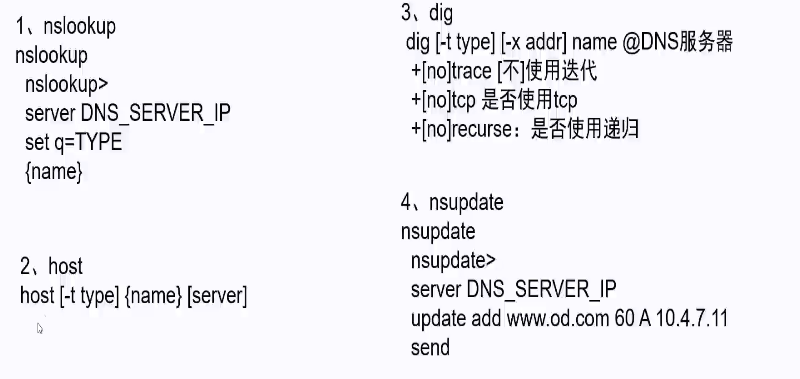1.安装
~]# yum install bind-utils

2.nslookup命令
交互式
[root@hdss7-11 named]# nslookup
> server 10.4.7.11
Default server: 10.4.7.11
Address: 10.4.7.11#53
> hdss7-11.host.com
Server: 10.4.7.11
Address: 10.4.7.11#53
Name: hdss7-11.host.com
Address: 10.4.7.11
/------------------------------------------------------------------以上是权威应答
> www.baidu.com
Server: 10.4.7.11
Address: 10.4.7.11#53
Non-authoritative answer: --非权威应答
www.baidu.com canonical name = www.a.shifen.com.
Name: www.a.shifen.com
Address: 39.156.66.18
Name: www.a.shifen.com
Address: 39.156.66.14
Name: www.a.shifen.com
Address: 2409:8c00:6c21:104f:0:ff:b03f:3ae
Name: www.a.shifen.com
Address: 2409:8c00:6c21:104c:0:ff:b02c:156c
/--------------------------------------------------------------------以上是非权威应答
非交互式
[root@hdss7-11 named]# nslookup www.baidu.com
Server: 10.4.7.11
Address: 10.4.7.11#53
Non-authoritative answer:
www.baidu.com canonical name = www.a.shifen.com.
Name: www.a.shifen.com
Address: 39.156.66.18
Name: www.a.shifen.com
Address: 39.156.66.14
Name: www.a.shifen.com
Address: 2409:8c00:6c21:104f:0:ff:b03f:3ae
Name: www.a.shifen.com
Address: 2409:8c00:6c21:104c:0:ff:b02c:156c
3.host命令
[root@hdss7-11 named]# host -t A hdss7-12.host.com
hdss7-12.host.com has address 10.4.7.12
[root@hdss7-11 named]# host -t A hdss7-12.host.com 10.4.7.11
Using domain server:
Name: 10.4.7.11
Address: 10.4.7.11#53
Aliases:
hdss7-12.host.com has address 10.4.7.12
[root@hdss7-12 named]# host -t PTR 12.7.4.10.in-addr.arpa 10.4.7.11
Using domain server:
Name: 10.4.7.11
Address: 10.4.7.11#53
Aliases:
12.7.4.10.in-addr.arpa domain name pointer HDSS7-12.host.com.
[root@hdss7-12 named]# host -t PTR 12.7.4.10.in-addr.arpa 10.4.7.12
Using domain server:
Name: 10.4.7.12
Address: 10.4.7.12#53
Aliases:
12.7.4.10.in-addr.arpa domain name pointer HDSS7-12.host.com.
4.dig命令
| 参数 | 说明 |
|---|---|
| +tcp | 使用tcp |
| +notcp | 使用udp |
| +norecurse | 使用迭代算法 |
| +recurse | 使用递归算法 |
| +short | 直接返回应答段 |
| @x.x.x.x | 指定dns服务器 |
- 查询A记录
[root@hdss7-12 named]# dig -t A hdss7-11.host.com @10.4.7.11
; <<>> DiG 9.11.4-P2-RedHat-9.11.4-9.P2.el7 <<>> -t A hdss7-11.host.com @10.4.7.11
;; global options: +cmd
;; Got answer:
;; ->>HEADER<<- opcode: QUERY, status: NOERROR, id: 44452
;; flags: qr aa rd ra; QUERY: 1, ANSWER: 1, AUTHORITY: 2, ADDITIONAL: 3
;; OPT PSEUDOSECTION:
; EDNS: version: 0, flags:; udp: 4096
;; QUESTION SECTION:
;hdss7-11.host.com. IN A //问 hdss7-11 的A记录是哪个ip
;; ANSWER SECTION:
hdss7-11.host.com. 60 IN A 10.4.7.11 //应答段
;; AUTHORITY SECTION: //返回的ns记录
host.com. 600 IN NS ns1.od.com.
host.com. 600 IN NS ns2.od.com.
;; ADDITIONAL SECTION: //附加,把ns的A记录也查出来了
ns1.od.com. 60 IN A 10.4.7.11
ns2.od.com. 60 IN A 10.4.7.12
;; Query time: 0 msec
;; SERVER: 10.4.7.11#53(10.4.7.11)
;; WHEN: Thu Dec 26 03:54:37 CST 2019
;; MSG SIZE rcvd: 133
- 查询PTR记录
[root@hdss7-12 named]# dig -t PTR 11.7.4.10.in-addr.arpa. @10.4.7.11 +short
HDSS7-11.host.com.
[root@hdss7-12 named]# dig -x 10.4.7.11 @10.4.7.11 +short
HDSS7-11.host.com.
5.nsupdate命令(仅交互式)
注意:不常用,需要在zone配置文件里声明allow-update { acl; };
nsupdate不会写到区域文件,它会写到xxx.jnl 日志文件
增
[root@hdss7-11 named]# nsupdate
> server 10.4.7.11
> update add 13.7.4.10.in-addr.arpa. 60 PTR hdss7-13.host.com.
> send
> quit
删
[root@hdss7-11 named]# nsupdate
> server 10.4.7.11
> update del 13.7.4.10.in-addr.arpa. 60 PTR hdss7-14.host.com.
> send
> quit
改
[root@hdss7-11 named]# nsupdate
> server 10.4.7.11
> update del 13.7.4.10.in-addr.arpa. 60 PTR hdss7-13.host.com.
> update add 13.7.4.10.in-addr.arpa. 60 PTR hdss7-14.host.com.
> send > quit
nsupdate使用小结:
- 优点:命令简单,便于记忆
不在手动变更SOA的serial序列号,自动滚动
不需要重启重载bind9服务/配置,生效快
可以通过配置acl实现远程管理
- 缺点:jnl文件无法使用文本文件的方式打开
只能依赖完全区域传送查看所有的区域的记录
更新操作复杂,先删后增
远程管理有安全隐患,需要加审计
动态域在rndc管理上多一步